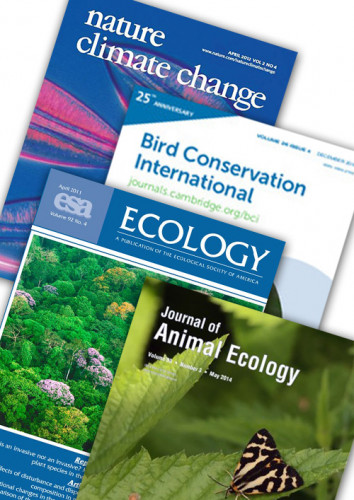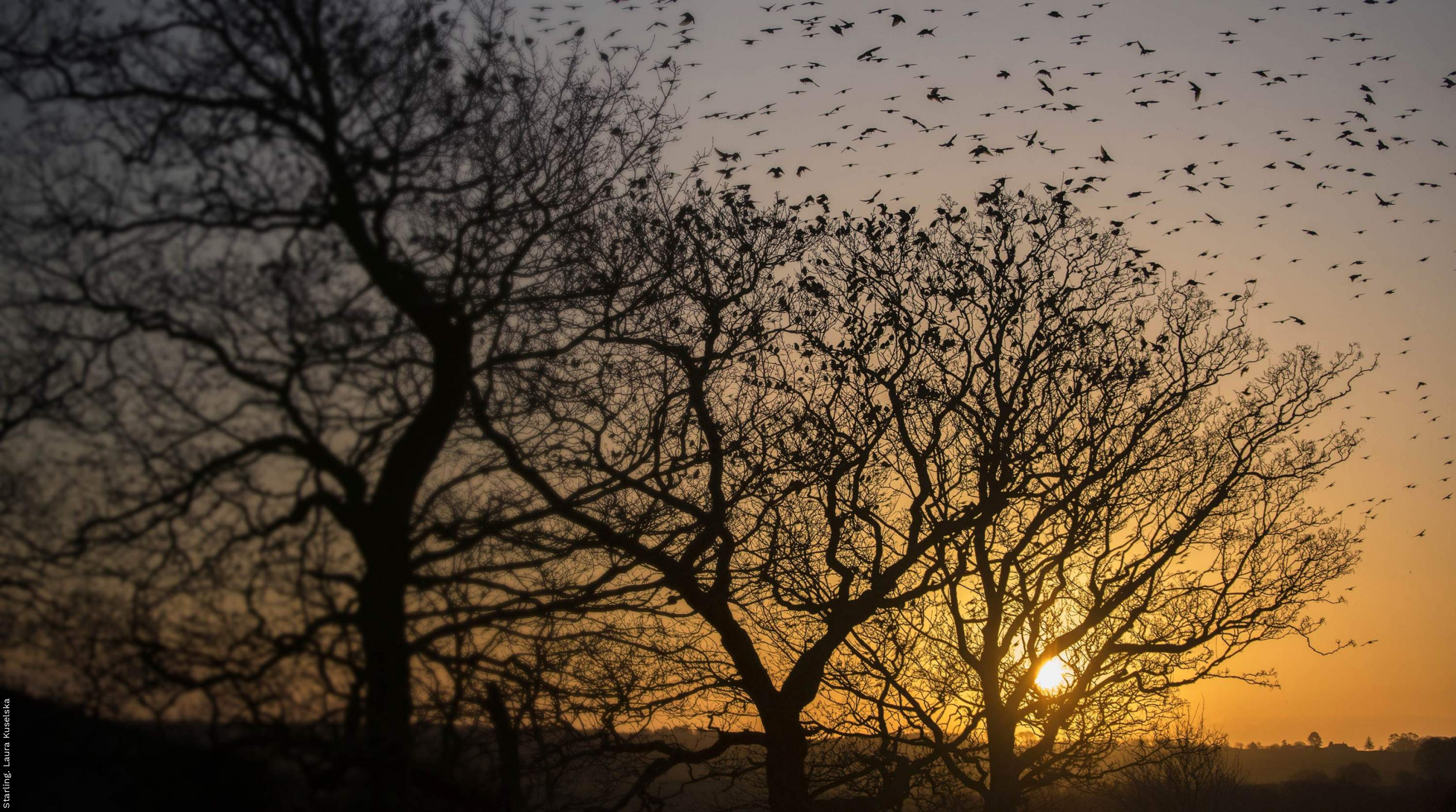Peer-reviewed papers

It is BTO’s policy to make public the results of our research. Our aim is to publish as much as possible of our work in the peer reviewed scientific literature. Many results are also published in our BTO Research Report series.
2005.
Evaluating the Breeding Bird Survey for producing national population size and density estimates.
Bird Study
52
: 42-54
Link to Article (DOI: 10.1080/00063650509461373)
2005.
Effects of temperature variability on egg mass and clutch size in Great Tits.
Condor
107
: 710-714
Link to Article (DOI: 10.1650/0010-5422)
2005.
Night-time behaviour of egg-laying tits.
Ibis
147
: 342-345
Link to Article (DOI: 10.1111/j.1474-919x.2005.00409.x)
2005.
Long term demographic monitoring of wader populations in non-breeding areas.
Wader Study Group Bulletin
106
: 17-29
View Abstract
2005.
Size and trends of the House Sparrow Passer domesticus population in Great Britain.
Ibis
147
: 552-562
Link to Article (DOI: 10.1111/j.1474-919x.2005.00427.x)
2005.
Case Study Part 2: Probabilistic modelling of long-term effects of pesticides on individual breeding success in birds and mammals.
Ecotoxicology
14
: 895-923
Link to Article (DOI: 10.1007/s10646-005-0035-3)
2005.
Garden Warblers: autumn moulting in the UK and birds with extra rectrices.
British Birds
98
: 266-267
2005.
Case study part 1: how to calculate appropriate deterministic long-term toxicity to exposure ratios (TERs) for birds and mammals.
Ecotoxicology
14
: 877-893
Link to Article (DOI: 10.1007/s10646-005-0034-4)
2005.
Spatial and structural uniformity of lowland agricultural grassland in England: a context for low biodiversity.
Grass and Forage Science
60
: 225-236
Link to Article (DOI: 10.1111/j.1365-2494.2005.00470.x)
2005.
'Save the North Sea' Fulmar Study 2002-2004: a regional pilot project for the Fulmar-Litter-EcoQO in the OSPAR area.
Book title: Alterra-rapport 1162
Alterra, Wageningen
View Abstract
2005.
Habitat selection by yellowhammers Emberiza citrinella on lowland farmland at two spatial scales: implications for conservation management.
Journal of Applied Ecology
42
: 270-280
Link to Article (DOI: 10.1111/j.1365-2664.2005.01007.x)
2005.
Nightingales Luscinia megarhynchos in scrub habitats in the southern fens of East Anglia, England: associations with soil type and vegetation structure.
Ibis
147
: 498-511
Link to Article (DOI: 10.1111/j.1474-919x.2005.00420.x)
2005.
Decline in Yellow Wagtail Motacilla flava flavissima breeding on lowland wet grassland in England and Wales between 1982 and 2002.
Bird Study
52
: 88-92
Link to Article (DOI: 10.1080/00063650509461377)
2005.
Changes in the numbers of breeding waders on lowland wet grasslands in England and Wales between 1982 and 2002.
Bird Study
52
: 55-69
Link to Article (DOI: 10.1080/00063650509461374)
2005.
Effects of land-use and agricultural management on birds of marginal farmland: a case study in the Ll?n peninsula, Wales.
Agriculture, Ecosystems & Environment
107
: 331-340
Link to Article (DOI: 10.1016/j.agee.2004.12.006)
2004.
What factors determine where invertebrate-feeding birds forage in dry agricultural grasslands?.
Ibis
146
: 99-107
Link to Article (DOI: 10.1111/j.1474-919X.2004.00346.x)
2004.
Managed realignment in the UK - the first 5 years of colonization by birds.
Ibis
146
Book title: Climate Change and Coastal Birds
: 101-110
Link to Article (DOI: 10.1111/j.1474-919X.2004.00334.x)
2004.
Rapid population decline in red knots: fitness consequences of decreased refuelling rates and late arrival in Delaware Bay.
Proceedings of the Royal Society B
271
: 875-882
Link to Article (DOI: 10.1098/rspb.2003.2663)
2004.
Monitoring terrestrial mammals in the UK: past, present and future, using lessons from the bird world.
Mammal Review
34
: 3-29
Link to Article (DOI: 10.1046/j.0305-1838.2003.00023.x)
2004.
Declining biodiversity in agricultural landscapes and the effectiveness of agri-environment schemes.
Ambio
33
: 499-502
2004.
Birds breeding in British gardens: an underestimated population?.
Bird Study
51
: 97-106
Link to Article (DOI: 10.1080/00063650409461340)
2004.
Habitat availability and use by Turtle Doves Streptopelia turtur between 1965 and 1995: an analysis of Common Birds Census data.
Bird Study
51
: 1-11
Link to Article (DOI: 10.1080/00063650409461326)
2004.
The utility of national ring recoveries for identifying the effects of an exceptional mortality event amongst seabirds.
Ringing & Migration
22
: 35-42
View Abstract
2004.
Testing solutions in grass-dominated landscapes: a review of current research.
Ibis
146
: 163-170
Link to Article (DOI: 10.1111/j.1474-919X.2004.00350.x)
2004.
Effects of reductions in organic and nutrient loading on bird populations in estuaries and coastal waters of England and Wales. Phase 2 Report. EN Research Report No 586.
English Nature, Peterborough
2004.
Tidal variation in numbers of waterbirds: how frequently should birds be counted to detect change and do low tide counts provide a realistic average?.
Bird Study
51
: 48-57
Link to Article (DOI: 10.1080/00063650409461332)
2004.
Quantifying the effects of habitat structure on prey detectability and accessibility to farmland birds.
Ibis
146
: 123-130
Link to Article (DOI: 10.1111/j.1474-919X.2004.00352.x)
2004.
Associations of garden birds with gradients in garden habitat and local habitat.
Ecography
27
: 589-600
Link to Article (DOI: 10.1111/j.0906-7590.2004.03984.x)
2004.
Rule-based predictive models are not cost-effective alternatives to bird monitoring on farmland.
Agriculture, Ecosystems & Environment
101
: 1-8
Link to Article (DOI: 10.1016/S0167-8809(03)00277-9)
2004.
Ringing recoveries confirm higher wader mortality in severe winters.
Ringing & Migration
22
: 43-50
View Abstract
2004.
Using the proportion of juvenile waders in catches to measure recruitment.
Wader Study Group Bulletin
104
: 51-55
View Abstract
2004.
The impact of climate change on birds.
Ibis
146
Book title: Climate Change and Coastal Birds.
: 48-56
Link to Article (DOI: 10.1111/j.1474-919X.2004.00327.x)
2004.
Differential distribution of Oystercatchers Haematopus ostralegus overwintering on the Wash, east England.
Bird Study
51
: 76-82
Link to Article (DOI: 10.1080/00063650409461335)
2004.
Importance of over-wintered stubble for farmland bird recovery: a reply to Potts.
Bird Study
51
: 94-96
Link to Article (DOI: 10.1080/00063650409461339)
2004.
The relevance of non-farmland habitats, uncropped areas and habitat diversity to the conservation of farmland birds.
Ibis
146
: 22-31
Link to Article (DOI: 10.1111/j.1474-919X.2004.00357.x)
2004.
Prey detectability: significance and measurement using a novel laser pen technique.
Wader Study Group Bulletin
103
: 50-55
View Abstract
2004.
Birds as biomonitors: principles and practice.
Bird Census News
13
Book title: Bird Numbers 1995, Proceedings of the International Conference and 13th Meeting of the European Bird Census Council, Pärnu, Estonia.
: 19-31
2004.
Survey design and sampling strategies for breeding bird monitoring.
Bird Census News
13
Book title: Bird Numbers 1995, Proceedings of the International Conference and 13th Meeting of the European Bird Census Council, Pärnu, Estonia.
: 19-31
2004.
Monitoring breeding bird in the United Kingdom.
Bird Census News
13
Book title: Bird Numbers 1995, Proceedings of the International Conference and 13th Meeting of the European Bird Census Council, Pärnu, Estonia.
: 101-112
2004.
The state of play of farmland birds: population trends and conservation status of lowland farmland birds in the United Kingdom.
Ibis
146
: 1-13
Link to Article (DOI: 10.1111/j.1474-919X.2004.00358.x)
2004.
Evidence for declines in populations of grassland-associated birds in marginal upland areas of Britain.
Bird Study
51
: 12-19
Link to Article (DOI: 10.1080/00063650409461327)
2004.
The use of winter bird crops by farmland birds in lowland England.
Biological Conservation
118
: 21-32
Link to Article (DOI: 10.1016/j.biocon.2003.06.003)
2004.
Long-term population changes among breeding shorebirds in the Outer Hebrides, Scotland, in relation to introduced hedgehogs Erinaceus europaeus.
Biological Conservation
117
: 151-166
Link to Article (DOI: 10.1016/S0006-3207(03)00289-1)



Share this page